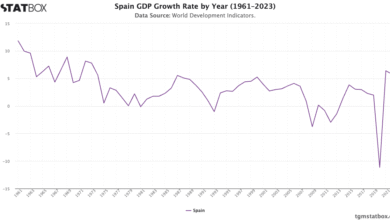May Jobs Report: What to Expect from Payroll Numbers

The May jobs report is poised to reveal a significant slowdown in hiring, with economists forecasting only 125,000 new jobs added to the nonfarm payrolls. This figure marks a sharp decline from April’s initial count of 177,000, reflecting a concerning trend in the labor market and the growing impact of economic uncertainties. Analysts are particularly focused on this employment report, as it could influence the Federal Reserve’s monetary policy, especially in light of rising inflation concerns. Investors are bracing for insights that will signal whether the current labor market dynamics justify a shift in interest rate strategies. As the release date approaches, the financial community is keenly awaiting the report that will illuminate the state of job growth in the U.S.
As the labor market grapples with fluctuating dynamics, the employment statistics for May are drawing considerable attention. The upcoming report will shed light on key factors such as job creation and economic health, offering a deeper understanding of employment trends. Anticipated figures suggest a marked slowdown, indicating potential ramifications for consumer confidence and spending. Amidst mounting concerns over inflation and geopolitical tensions, these employment metrics will serve as critical indicators for analysts and policymakers alike. The performance of the job market during this pivotal month will not only reflect current conditions but could also shape future decisions by the Federal Reserve.
Analyzing the May Jobs Report: What to Expect
The expectation leading into the May jobs report is tinged with cautious optimism as analysts predict a slower pace of hiring. Economists forecast a gain of just 125,000 jobs, a stark decrease from April’s figures of 177,000, indicating potential challenges in the labor market. This anticipated slowdown could be a signal of a larger trend, influenced by external factors such as rising tariffs and overall economic uncertainty, which are causing companies and consumers to adopt a more conservative approach to hiring.
While the May nonfarm payroll report is crucial for understanding employment trends, the real implications of these numbers extend beyond mere statistics. Investors are closely monitoring how the upcoming release will affect Federal Reserve policy and future interest rate decisions. If the jobs report reflects a significant downturn, it could prompt a re-evaluation of monetary policy, particularly amid concerns about inflation driven by tariffs.
The Impact of Inflation on the Labor Market
Inflation continues to be a looming concern as it weighs on the labor market. Rising prices can erode consumer purchasing power, thereby impacting job growth and overall economic activity. As reported indicators show diminishing optimism among business owners and consumers alike, both the Federal Reserve and market participants are keenly aware of these inflationary pressures. With employment levels potentially slowing, how businesses respond to inflation will be critical in shaping future economic conditions.
Recent data from the employment sector highlights this delicate balance. While job growth is expected to decline in May, the broader context reveals a labor market that has displayed resilience over the past months. However, a more comprehensive analysis suggests that inflation could soon start affecting labor dynamics significantly if wages do not keep pace with increasing costs.
Federal Reserve’s Role in Shaping Job Growth
As the May jobs report approaches, the role of the Federal Reserve becomes more pronounced, particularly regarding its influence on the labor market. The Fed’s decisions around interest rates are not just about controlling inflation; they also directly impact employment trends. A solid jobs report could ease fears of a recession and bolster confidence in the economy, whereas a disappointing report may push the Fed to adopt a more dovish stance on interest rates.
Policymakers at the Federal Reserve must navigate these complexities carefully. Insights from past data suggest that while employment continues to show growth, the pace could be hampered by external factors like tariffs. Consequently, the Fed’s assessment during and after the revelation of the May employment report will be pivotal in determining their approach to interest rates moving forward.
Understanding Nonfarm Payrolls: Broader Economic Indicators
The nonfarm payrolls figure remains one of the most closely watched economic indicators, and for good reason. It provides a comprehensive snapshot of job creation across various sectors in the economy, excluding the agricultural industry. This measure helps analysts, investors, and policymakers gauge the health of the economy and anticipate future trends. As the May report approaches, interest will center not only on the numbers themselves but also on sectors that show significant growth or decline.
Analyzing these payroll figures in conjunction with other economic data, such as unemployment rates and wage growth, presents a more nuanced picture of the labor market. If the May jobs report reflects stagnation or decline in payroll numbers, it may necessitate a closer look at contributing factors like manufacturing trends, service sector shifts, and consumer sentiment—each playing a vital role in understanding the overall economic landscape.
Diverging Opinions on Job Growth Predictions
The forecast for the May jobs report reveals a divergence in opinions among economists and financial institutions. Some, like Goldman Sachs, predict a payroll growth figure below consensus at just 110,000, while others, such as Bank of America, anticipate a slightly healthier number closer to 150,000. These varying predictions reflect the uncertainty that currently encompasses the labor market, driven by external pressures such as tariffs.
Navigating through these predictions requires an understanding of the underlying factors influencing job growth. With public sentiment becoming increasingly wary, the potential for job market deterioration is palpable. However, the forthcoming jobs report may also unveil resilience, signaling that while the labor market may be slowing, it is not collapsing, which is critical information for investors and policymakers alike.
The Importance of Sentiment in Economic Forecasts
Public and business sentiment holds significant weight when forecasting economic trends, particularly in the labor market. Recent sentiment surveys indicate a shift toward a more pessimistic outlook, influenced largely by fears surrounding tariffs and inflation. This sentiment can affect hiring decisions, which in turn impacts nonfarm payroll numbers. A weak sentiment could lead businesses to adopt a cautious approach, reducing job openings and hiring.
However, it’s important to note that sentiment is just one piece of the puzzle. Hard economic data, like private payroll growth reported by ADP, suggests that while sentiment may be low, the job market has not entirely followed suit. Analyzing both kinds of data provides a more holistic view that can help in better predicting the trajectory of the labor market and, consequently, the economy.
Tariffs and Their Repercussions on Employment
The ongoing tariff negotiations and their potential impacts on employment are critical topics leading up to the May jobs report. With tariffs in place, companies are feeling the squeeze, prompting them to reassess their hiring practices and operational strategies. As economists predict, any significant drop in job creation due to tariffs could exacerbate fears of a slowing economy, thus influencing market sentiment and policy decisions.
Expected impacts on the labor market are multifaceted. While some industries might experience immediate job losses, others could see growth as they adapt to changing economic conditions. Policymakers are left to closely monitor these shifts, as effective management of tariffs and trade relationships will be pivotal in sustaining job growth and economic stability.
The Current Economic Climate: A Balancing Act
As we approach the release of the May jobs report, understanding the current economic climate is crucial. This balancing act between rising inflation and a possibly cooling labor market presents unique challenges for businesses and policymakers. While growth in employment numbers is vital for economic health, concerns regarding inflationary pressures cannot be ignored. Businesses are bracing for how these factors interplay as they plan for future growth and expansion.
Additionally, consumer perception of the economy influences spending, which accounts for a significant portion of economic activity. As consumer confidence wanes due to fears surrounding tariffs and economic instability, this could lead to decreased demand in various sectors, further impacting job growth and economic forecasts.
Future Projections for Job Growth Insights
Looking ahead, future projections for job growth will be highly dependent on numerous factors highlighted in the May jobs report. Analysts and market participants will be keen to determine whether the anticipated slowdown is temporary or indicative of a larger trend within the labor market. The report will likely shed light on how hiring practices are responding to the dual pressures of inflation and external economic uncertainties.
Furthermore, understanding job growth in relation to overall economic activity will help shape forecasts for the Federal Reserve’s policy decisions. If the May report reveals slower job growth without alarming declines, it may provide some breathing room for the Fed to evaluate their strategy regarding interest rates without panic. Thus, the upcoming jobs data will be critical in forming economic predictions for the months ahead.
Frequently Asked Questions
What can we expect from the May jobs report regarding job growth?
The May jobs report is expected to show a gain of around 125,000 jobs, which indicates a slowdown in job growth compared to April’s tally of 177,000. This decline may reflect concerns over the labor market amidst rising inflation and economic uncertainty.
How do the May nonfarm payroll numbers affect Federal Reserve policy?
The May nonfarm payroll numbers will likely influence Federal Reserve policy as investors assess the implications of slower job growth on monetary policy and potential interest rate adjustments. A weaker-than-expected report could prompt the Fed to reconsider future rate cuts.
What does the employment report indicate about the current labor market?
The employment report for May suggests a cooling labor market, with private payrolls reflecting a modest increase. Indicators such as rising jobless claims and lower job creation numbers signify growing caution among employers amid concerns about tariffs and economic uncertainty.
How significant are the predictions for the May nonfarm payroll numbers?
Predictions for the May nonfarm payroll numbers suggest a potential drop to around 125,000 jobs, which could indicate a significant moderation in job growth. If the actual number falls below 100,000, it may raise concerns about a possible recession.
What economic factors are influencing the May jobs report?
Economic factors influencing the May jobs report include rising tariffs, which are creating uncertainty in the labor market, and consumer sentiment, which has turned negative. These factors combined may affect job growth and the overall economy.
Why is the May jobs report critical for understanding economic activity?
The May jobs report is crucial because it provides insights into labor market conditions, which are a key driver of consumer strength. Since consumer spending accounts for about 70% of U.S. economic activity, understanding trends in employment is vital for gauging overall economic health.
How have sentiment surveys impacted expectations for the May employment report?
Sentiment surveys indicate diminishing optimism about the economy, which has influenced expectations for the May employment report. With softer data and rising inflation concerns, economists predict a slowdown in job growth reflected in the report.
What do experts predict regarding the unemployment rate in the May employment report?
Experts anticipate that the unemployment rate will remain steady at 4.2% in the May employment report. This stability suggests that while job growth may be slowing, the overall labor market remains relatively balanced.
How could the May jobs report affect Treasury yields?
Depending on the results of the May jobs report, stronger-than-expected job growth could lead to higher Treasury yields, as markets may respond to increased pressure on the Federal Reserve regarding interest rates. Conversely, a weaker report could ease such pressures.
What role do tariffs play in the context of the May jobs report?
Tariffs are expected to have a significant impact on the May jobs report, contributing to the cooling of the labor market as companies adjust to increasing costs and economic uncertainty, which may affect their hiring decisions.
| Key Metrics | Expected Values | Previous Values | Comments |
|---|---|---|---|
| Nonfarm Payroll Jobs Added | 125,000 | 177,000 | Slower hiring due to rising tariffs and economic uncertainty. |
| Average Monthly Gain (Year-to-Date) | 144,000 | N/A | Current projections show a notable decrease in job growth. |
| Unemployment Rate | 4.2% | 4.2% | Expected to remain unchanged, reflecting stability in the labor market. |
| Average Hourly Earnings (Monthly Gain) | 0.3% | N/A | Shows continued wage growth amid inflation concerns. |
| Annual Average Hourly Earnings Increase | 3.7% | N/A | A reflection of the ongoing pressure from inflation. |
Summary
The May jobs report is anticipated to reveal a slowdown in hiring, with a forecasted gain of just 125,000 jobs. This marks a notable decrease from April’s figures and is below the average monthly growth for the year. Given the balance between a decelerating labor market and rising inflation, this report will hold significant implications for Federal Reserve policy and investor reactions, as any substantial dips could raise concerns over economic stability.



